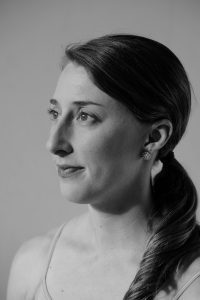Ashlie Kirby holds a BFA from the University of California at Santa Barbara and an MFA from University of North Carolina-Greensboro. She was a professional dancer in NYC for nine years, working for choreographers Jessica Gaynor and Pam Tanowitz and won a prestigious Bessie award for her performance in Tanowitz’s work. Ultimately she discovered that her professional career had left her feeling burnt out and craving more. Ashlie rediscovered her love for dance at DEL and has been a dance educator ever since!
Read Ashlie’s story below.
1. What is your current position in dance education and how did it come to be? Please describe your role.
I am the K-8 Dance Educator at Bentley School, an independent school in Oakland, California. I design and implement dance curriculum for lower and middle school students. In addition to the daily dance classes I teach, I find myself engaging young students in dance in many ways throughout my day. I might collaborate with the science teacher to lead the first graders through an exploration of balance, teach the fifth grade Mandarin class a dance inspired by tai chi, lead sixth graders and kindergartners though a partnered exploration of shape, or choreograph a number for the Middle School Musical!
2. Please describe your PATHWAY to that job in a short narrative starting with your earliest dance experience.
I started dancing ballet at a young age and discovered modern dance at the University of California at Santa Barbara, where I got my BFA in Dance. After college I moved to New York and danced professionally as a modern dancer for nine years. At a certain point in my professional career I began to feel burned out. I disliked how elitist the dance world could sometimes be and wanted to reconnect with my love for dance. During this time a dance educator friend suggested I take a course at the Dance Education Laboratory at the 92nd Street Y. During these courses I rediscovered why I loved dance. I remembered how much I loved to move, express myself and be part of a community. I wanted all people, especially children, to be able to experience this joy. I kept dancing professionally, but also began teaching in schools, where I felt I could reach the largest number of children. I am lucky I have been able to continue my career as a professional dancer alongside my career as a dance educator and have found the two feed and inspire one another.
3. What is the most helpful lesson you learned at DEL? And during your graduate students in Dance Education at UNCG?
The most helpful axiom I learned at DEL is: everyone is a dancer and dances can be made about anything! To move your body in an expressive way is a fundamental part of being human. The most influential idea I took away from my time at UNCG is that as a dancer you can be many things. To be a dancer is to be an artist, and to be an artist you must have access to a wide range of qualities, from dark to humorous to ethereal. To be an interesting artist you must first be a person who has an interest in many things.
4. What is one thing you would tell young dancers about the importance of dance education? Or what do you wish you had known as a young dancer?
A young dancer often times wants only one thing: to dance! I wish that as a young dancer I could have seen that success in the field of dance can look many different ways. Even if you do get that one in a million job in a dance company you still have to find ways to feed yourself as an artist and ways to sustain yourself in the field. As a young dancer I thought if I did not quickly secure a coveted spot in a large dance company then I did not want to continue dancing. How much I would have missed if I had followed through with that plan! My advice is to be persistent in wanting dance in your life, but do not narrow your scope as to how dance might exist in your life. Redefine what success looks like for yourself.
As for the importance of dance education, I could go on and on about the importance of dance education in young people’s lives. Arts education in music, visual, theater arts and dance is essential for every child. But in addition to bettering the lives of children, dance education also serves to better the field of dance. Can you imagine if every person graduated high school with 13 years of experience in watching and talking about dance? What an informed, appreciative and large audience we could create for dance! Can you imagine if everyone got the opportunity to start composing their own dances starting in Kindergarten? What innovative, intelligent and ground-breaking choreographers we could create! If we want to create an audience for dance, as well as advance dance as an art form, dance education is the first step.

